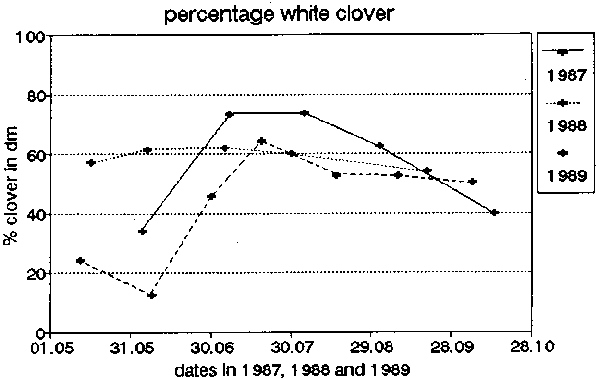T. Baars and M.J.H. van DongenLouis Bolk Instituut, Department of Research in Biodynamic and Organic Agriculture, Hoofdstraat 24, 3972 LA Driebergen, The Netherlands
Introduction
Materials and methods
Results and discussion
References
The presence and performance of legumes in grassland is of great importance concerning the production possibilities of organic farming systems (Baars, 1992). Besides such factors as year to year differences and soil types, adequate management of grass/white clover mixtures plays an important role in the establishment and development of white clover. Especially in organic farming, management is important because of the lack of using nitrogen as a factor in controlling yield. In order to assess the effects of grass species on clover development an experiment was conducted on a drought-sensitive clay soil in the Netherlands.
The experiment was carted out from 1987 to 1989. In an arable crop rotation a three year ley of grass/clover was sown in September 1986 after winter wheat on a riverclay soil. Two mixtures were compared: tetraploid perennial ryegrass, cvs Condesa and Citadel, white clover cvs Retor and Wilka (=TA) and a mixture with four grass species (perennial ryegrass, meadow fescue, timothy, smooth-stalked meadow grass) and the extra species tall fescue and cocksfoot (because of drought-sensitive soil type) and white clover (cv Retor) (=BG). The plots (3.8 ha) were managed by the farmer and were cut as well as grazed. At sowing time 25 t/ha composted FYM was applied. During the experiment manuring took place in May the second year and in March and June the third year, each time with 15 m3/ha slurry.
Yield and clover content was measured at each harvest and dry matter content and nitrogen content were determined.
During three years no differences in DM yield between the mixtures were recorded. Total measured DM yield varied from 8.5 to 10.5 t/ha. In the third year differences in clover content occurred with TA having the highest content (47 vs 36 %). This was mainly due to a strong development of tall fescue in the BG-mixture during a dry period in this year. Until August the clover content in the DM in BG was 15 % lower than in TA. In TA the white clover DM yield remained constant over the years (5 t DM/ha). It is concluded that there was a slightly preference to the TA mixture. Because of the strong competition of tall fescue to white clover, it is not recommended to use this species in a grass/clover mixture.
Year to year variation in clover development is shown in Figure 1. In the second year clover content was already high in early season (60 % in the DM). In year 1 and 3 clover development showed a more common pattern with the highest content in summer (60-70 %) and a decline in late season. This is reflected in the N-content in the DM. In year 2 the N-content in early season was high (35 gN/kg DM) compared with year 1 and 3 (22 gN/kg DM). This shows the importance of good clover development in early season, which is connected to a low mortality of clover in winter. Besides management factors and severity of winter, breeding of new clover varieties with the capacity of early seasonal growth would be of interest. In years 1 and 3 there was an unbalance in the feeding quality, ie. low N-contents in spring and high N-contents in autumn. In order to use the available energy and protein in the forage as best as possible this unbalance needs to be corrected. In spring a farmer can feed protein rich silage or concentrates, while in autumn, energy rich forage as maize or fodderbeet is recommended.
percentage white clover - Figure 1. Clover content (%) in DM in each harvest for three years (average of the two mixtures).

In general it can be concluded that especially in an arable crop rotation situation with relatively low soil-N contents, the clover can develop vigorous in summer to contents of 80 % in the DM. The mentioned imbalance in N-content can be extreme in the first years after resowing. In a comparable situation Baan Hofman (1988) also obtained low N-contents in spring and higher N-contents after about the middle of July. As the ley becomes older the organic matter content in the soil builds up as well as the N-content. The imbalance in N-content during the growing season will then be less extreme.
Figure 2. Nitrogen content (g N/kg DM) in each harvest for three years (average of two mixtures).

BAARS, T. (1992) De biologische melkveehouderij. Misset, Doetinchem.
BAARS, T. and VAN DONGEN, M.J.H. (1992) Vergelijking gras/klavermengsels 1987-1989; Steenen Muur. Louis Bolk Instituut, Driebergen.
BAAN HOFMAN T. (1988) Bijdrage van vlinderbloemigen aan de stikstof- en ruwvoedervoorziening van alternatieve landbouwbedrijven. Gebundelde Verslagen Nederlandse Vereniging voor Weide- en Voederbouw nr. 28.